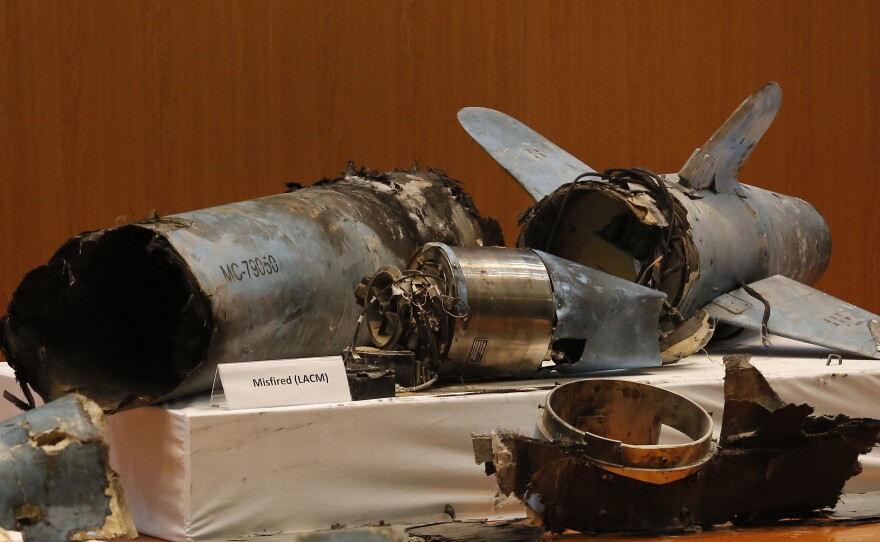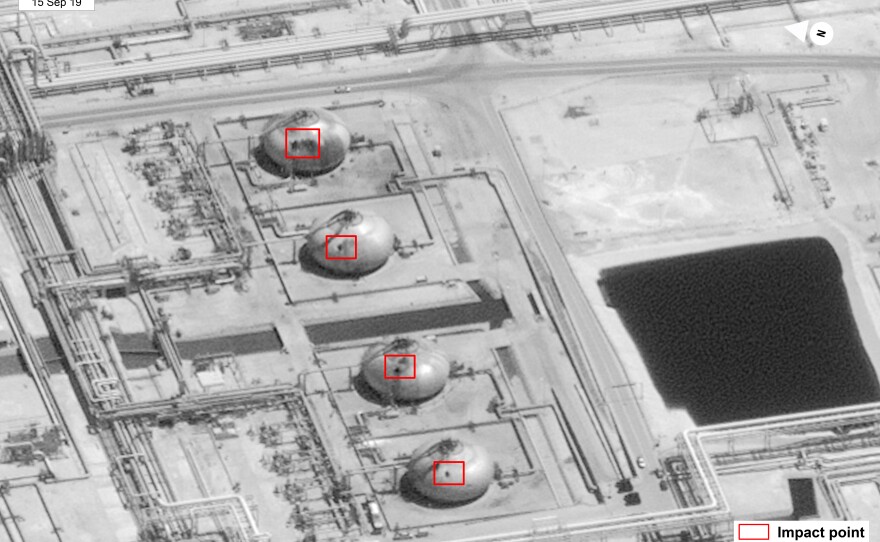On Sept. 14, a major Saudi oil processing plant was rocked by a series of explosions. The facility, and another oil field to the south, had been attacked from the air. Here's what we know — at this time — about the attacks based on physical evidence.
The strike was large and sophisticated
Images from commercial satellites released by the U.S. government show at least 17 points of impact at the two sites. The larger facility, known as Abqaiq, is one of the world's most important oil production facilities and has long been a potential target for attack. Within that vast plant, the perpetrators seemed to have singled out valuable equipment that would be difficult to replace and storage tanks that might contain flammable materials.

The group that has claimed responsibility probably didn't do it
Shortly after the attack, Houthi rebels in Yemen announced that they had launched drones against the Saudi facilities. The Houthis have conducted numerous drone attacks inside Saudi Arabia in the past, but there are a number of reasons to question their latest claim.
The first reason is simple math: There were 17 impact points, but Houthi spokesman Yahya Saree said that only 10 drones were launched by the rebel group.
Second is the matter of distance. The facilities that were struck lie roughly 500 miles from Yemen's border with Saudi Arabia. The Houthi weapons that have been used thus far simply don't have the range.
Third is the level of sophistication of the attack, according to Fabian Hinz, a research associate at the James Martin Center for Nonproliferation Studies in Monterey, Calif. "Would the Houthis be capable of flying a single drone or two drones into Abqaiq? I would say yes," Hinz says. "But would they be able to conduct such a vast coordinated mission to strike the facility with so much success? I would honestly say no."
Saudi Arabia has shown wreckage of drones and missiles that look Iranian
Even before the Saudi announcement, unverified photos popped up on Twitter that showed the wreckage of a missile in the desert with striking similarities to Iranian technology.

At a news conference Wednesday, Col. Turki al-Maliki, spokesman for the Saudi-led coalition fighting Houthi rebels in Yemen, displayed the remains of several missiles and drones that he said were recovered from the attacked facilities and the areas surrounding them.
At least one of the delta-wing drones looks like a type that previously appeared at a military exhibition in Iran, according to images displayed by Maliki and verified by outside experts.
The missiles Maliki described as being similar to Iran's Ya-Ali cruise missile, a kind of land-attack missile, are capable of traveling hundreds of miles with a small warhead. Hinz believes the missiles more closely resemble another Iranian design, a variant of which is known as the Quds 1.
Regardless of the exact type, the missile is clearly Iranian, says Hinz. "I would say there's little doubt that the cruise missiles we've seen originated in Iran."
The impacts on the site were made by objects coming from the west or northwest
Satellite images show that storage tanks at Abqaiq were struck from a northwest direction, Maliki says. He also claims that debris from three cruise missiles that failed to reach Abqaiq were recovered from north of the site. The trajectories suggest the missiles were launched from Iran or Iraq.
Frank Pabian, a longtime imagery analyst, says the impacts look like they may have struck from the west.

Regardless, Hinz says, the direction of the impact doesn't necessarily indicate the launch point. Both cruise missiles and drones can take circuitous routes to their targets.
Still, says Hinz, "If we talk about the general balance of probability, it's much more likely they came from the north."
And Yemen is to the south.
Other sources of information may soon be available
The U.S. military monitors the region closely with satellites, drones, radar and other sensors. According to NPR's Tom Bowman, Pentagon officials say they have imagery of Iranian forces inside Iran preparing for a strike before the attack. So far, the U.S. has not released any evidence it collected of those preparations or of the attack itself.
It may also be possible to glean more details from the wreckage of the drones and missiles. Maliki noted in his news conference that experts continue to analyze the hardware of the GPS-guided drones. It may be possible to extract the route they flew before crashing. A similar analysis of drone boats launched by the Houthis in 2016 revealed 93 sets of coordinates that provided clues about the boats' mission.
Copyright 2023 NPR. To see more, visit https://www.npr.org. 9(MDAzMjM2NDYzMDEyMzc1Njk5NjAxNzY3OQ001))







